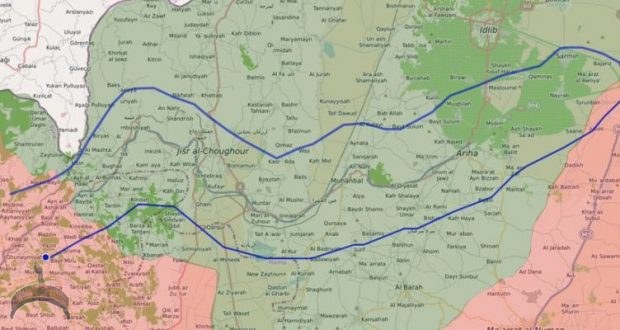Following 6 hours of grueling negotiations, including direct negotiations between Putin and Erdogan, the parties have finally agreed to the following:
- A ceasefire will begin at midnight.
- Russia and Turkey will jointly patrol the M4 highway (M5 now belongs to Damascus). A 6km buffer zone will have to be created and enforced on each side of M4 by the March 15th (see map above)
- Both parties have reaffirmed their commitment to Syria’s sovereignty and territorial integrity.
- Both parties have reaffirmed their commitment to a create the conditions for a return of the refugees.
- Both parties have reaffirmed that this conflict has no military solution.
Furthermore, there was a lot of things which were left unsaid, but understood by all:
- The recent military gains of the Syrian military will not be disputed and otherwise challenged. The new line of contact has now become official.
- Russia and Syria will continue to fight all the organizations which the UNSC has declared “terrorist” (al-Nusra, al-Qaeda, and all their franchises irrespective of any “rebranding”).
- Moscow remains as committed to the protection of the legitimate Syrian government as ever.
From the above we can also deduce the following:
- Erdogan’s Blitzkrieg has failed. Initially, the Turkish drones inflicted major damage on the Syrian forces, but the latter adapted extremely quickly which resulted in what the Russians jokingly referred to as “dronopad” which can roughly be translated as “dronerain”.
- The Turks were clearly shocked by the Russian decision to bomb a Turkish battalion. What apparently happened is this: two Syrian Su-22 (old Soviet aircraft) bombed the convoy to force it to stop, then a pair of Russian Su-34 (the most modern Russian all-weather supersonic medium-range fighter-bomber/strike aircraft) dropped heavy ordinance on the convoy and surrounding buildings killing scores of Turkish special forces). Both sides decided to “blame” the Syrians, but they don’t fly Su-34, and everybody knows that.
- Erdogan understood that he either had to double down or declare victory and leave. He wisely chose the latter, at least as a temporary measure.
- Neither NATO nor the EU showed any signs of wanting to join Turkey’s war on Syria (because that is what we are really dealing with here), and neither did the USA. Since I cannot call that decision “wise” (there is no wisdom of any kind left in western regimes), I will call it simply “prudent” as Russia was not about to allow Turkey to invade Syria.
- Iran, Hezbollah, and Libya all declared their willingness to fight the Turks for as long as needed and anywhere where needed.
In spite of these developments, it is pretty clear that internal Turkish politics will continue to force Erdogan to engage in what is politely called “neo-Ottoman” policies aka phantom pains for a lost empire. The obvious solution for Russia is to further arm the Syrians, especially with modernized versions of the Pantsir SAMs which have proven very effective against drones, MLRS rockets and even mortars.
The main Syrian problem is a lack of numbers. Until more forces are equipped, trained, deployed and engaged, the Russians need to provide a much stronger air defense capabilities to Syria. The Syrians have done miracles with old, frankly outdated, Soviet equipment (which, considering its age and lack of proper maintenance, has performed superbly), but now they need much better Russian gear to defend not only against Turkey, but also against the Axis of Kindness (USA+Israel+KSA).
Furthermore, it is my opinion that the Russian task force in Khmeimim and Tartus is too big and not well balanced. Khmeimin needs many more Su-25SM3 and a few more Su-35S/Su-30SM to protect them. The naval base at Tartus lacks ASW capabilities, as does much of the Russian naval task force in the eastern Mediterranean. And while the Russian Navy has a number of ships with “Kalibr” cruise missiles onboard, their numbers are, again, inadequate, which means that the Russian Aerospace Forces need to deploy as many Kalibr-capable aircraft in southern Russia as possible. Both Tartus and Khmeimim are pretty close to the Idlib province (that is also were the “good terrorist” tried to strike Russian forces from which, thanks to the successful Syrian offensive, they now cannot do anymore!). This suggests to me that Russia ought to declare a larger exclusive air control zone over both of this locations, and beef up the numbers of missiles and launchers the Russian air defenses will have to enforce it.
Finally, I think that Erdogan has outlived his utility for Russia (and for Turkey, for that matter!). He clearly is a loose cannon which, according to some rumors, even the Turkish public opinion is getting fed up with. Russia should not neglect that public opinion. Then there are the Libyans, “Field Marshal” Khalifa Belqasim Haftar, whose forces seems to have been extremely successful against the Turkish forces in Libya. The Russians are, quietly, supporting Haftar who, while not exactly an ideal ally for Russia, can prove useful. What the Russians need to do next is to explain two things to Erdogan and his ministers:
- If you attack again in Syria, you will be defeated, possibly worse than the first time around
- If you mess with our geostrategic interests, we will mess with yours
The only party which the Russians should never arm are the Kurds, who are even more unreliable than Erdogan and who are basically an Israeli asset to destabilize Turkey, Iraq, Syria and Iran. Russia should, however, talk to the Kurds (all factions) and convince them to accept a large cultural autonomy inside Syria, Iraq and Iran. Turkey could be added to this list, but only once a trustworthy government comes to power in Ankara. Under no circumstances should Russia arm the Kurds.
Right now, the best Russian ally in the region is Syria. This is the country which Russia needs to make safe by creating a truly modern air defense network. The Russians have already done a lot towards this goal, including integrating their combat management and EW systems, but that is not enough. While Russian aid and Syrian skills have forced the Israelis to conduct mostly symbolic and ineffective air strikes, often with missiles shot from outside the Syrian airspace, and while many (most) Israeli missiles were destroyed by the Syrian air defenses, it is pretty clear that both the Turks and the Israelis feel that if they launch missiles from long distance they are relatively safe. That perception needs to be changed, not only to force the Turks and the Israelis to shoot from even further and accept even more losses, but also to show the US, NATO and Europe that the Syrian air defenses are capable of making anything short of a massive attack pointless (and a massive attack costly).
We should also note that the Turkish propaganda machine has been very effective. Yes, a lot of what they said was self-evidently “feelgood” nonsense (thousands of dead Syrians, hundred of tanks, etc.) , but their footage of a Turkish drone striking a Pantsir in Libya did, at least initially, impress those who don’t understand air defense warfare (destroying a single isolated first-generation Pantsir is not that hard, especially from right above it, but destroying a Pantsir position in which launchers protect each other is quite different. And if that Pantsir position is protected “below” (AA+MANPADS) and “above” (medium to long range SAMs), then this becomes extremely difficult).
This war is not over and it won’t be until Erdogan is removed from power. Frankly, Russia needs a stable and trustworthy partner on her southern border, and that won’t happen until the Turks ditch Erdogan. The problem here is that God only knows who might succeed him, should the Gulenists seize power, that will not be good for Russia either.
And here we come back to the murder of General Suleimani. Frankly, the Iranians are spot on: the two things which made the Middle-East into the bloody mess it has been for decades are 1) Israel and 2) the USA. The end goal for the former is a one-state solution, whether accepted or imposed. The intermediate goal ought to be to get the US out of Afghanistan, Iraq, Syria and, possibly, Turkey. Erdogan is crazy and desperate enough (not to mention vengeful) to at least bring this intermediate goal one step closer by alienating the US and NATO. So the Russian game plan ought to be obvious: first, use military means to “contain Erdogan inside Turkey” and, next, engage in long term efforts to prepare for a post-Erdogan Turkey. Then let the SOB destroy himself.
I don’t believe that peace is possible between a secular Syria and a Takfiri-backing Turkey. And I sure don’t believe that the Takfiris can be remolded into any kind of “democratic opposition”. Thus the real end-goal for Russia and Syria will always be military victory, not “peace” (assuming that concept of “peace with the Takfiris” makes any sense at all, which it doesn’t). The Russians know that, even if they won’t admit it.
For the time being, what we see is the first phase of the Turkey-Syria war ending and for the next couple of weeks we shall see a transition into some other phase which will probably be one in which, surprise surprise, the Turks fail to remove all the Takfiri nutcases from Idlib which will then give Syria and Russia a legal reason to take direct action again. In theory, at least, Erdogan could decide to pour the Turkish armed forces across the border, but the closer they will get to Khmeimim and/or Tartus, the more dangerous the stakes for Turkey and for Erdogan personally.
The key to success for the Axis of Resistance is to make Syria too tough to crack. I hope that Russia, Iran, Syria and Iraq will continue to work together, hopefully with Chinese aid, to create such a Syria.
The Saker
 Ọmọ Oòduà Naija Gist | News From Nigeria | Entertainment gist Nigeria|Networking|News.. Visit for Nigeria breaking news , Nigerian Movies , Naija music , Jobs In Nigeria , Naija News , Nollywood, Gist and more
Ọmọ Oòduà Naija Gist | News From Nigeria | Entertainment gist Nigeria|Networking|News.. Visit for Nigeria breaking news , Nigerian Movies , Naija music , Jobs In Nigeria , Naija News , Nollywood, Gist and more








